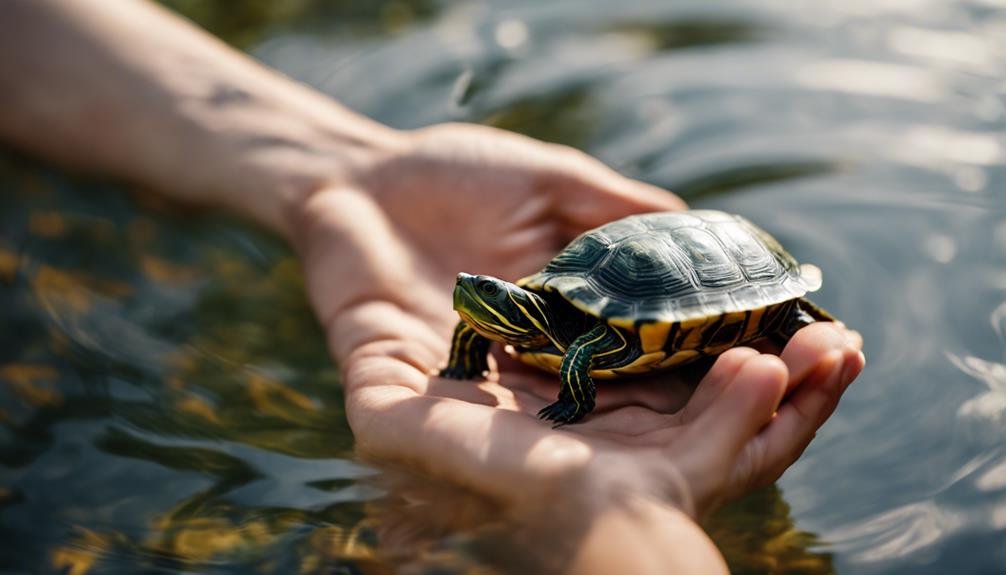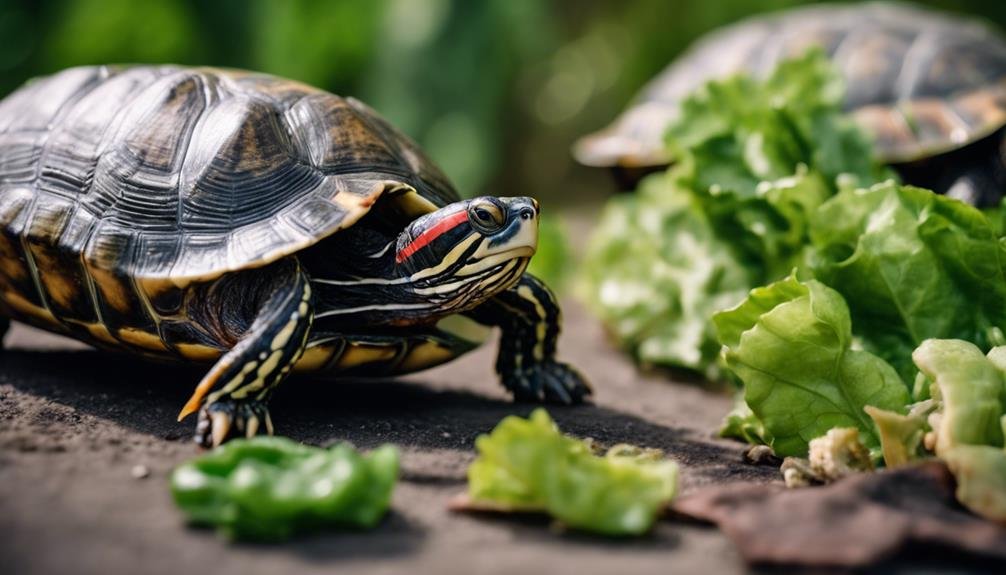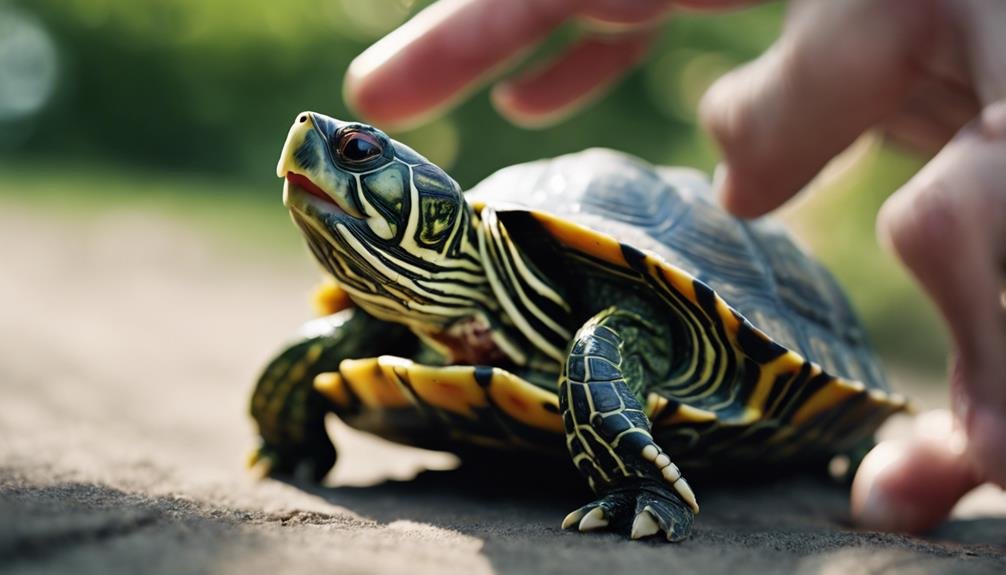You might have considered adding a red-eared slider to your family, attracted by their vibrant markings and engaging behaviors. However, one must ask themselves, ‘Do red-eared sliders bite?’ The answer isn’t as straightforward as a simple yes or no. These turtles can bite if they feel threatened or mistake their fingers for food, a situation that’s more common than you might think. But don’t let this deter you just yet. Understanding the nuances of their behavior and how to interact with them safely can transform your experience. Let’s explore what prompts these creatures to bite and how you can create a harmonious relationship with your shelled friend, ensuring your safe and enjoyable interactions.
Key Takeaways
- Red-eared sliders may bite if they feel threatened or stressed or if their fingers are mistaken for food.
- Bites can be painful and potentially break the skin, requiring proper care.
- Younger turtles and those in cramped habitats may exhibit more biting behavior.
- Proper handling and care, including avoiding sudden movements, reduce the risk of bites.
- Creating a comfortable environment with adequate space and hiding spots helps minimize stress and aggression in turtles.
Understanding Red Eared Slider Behavior
Understanding the behavior of red-eared sliders is crucial to preventing bites. These turtles may bite if they’re stressed, scared, or threatened. Such reactions are natural and can be minimized with the right approach. Recognizing what triggers these behaviors in your turtle is the first step toward preventing unwanted incidents.
A common reason for a bite can be the turtle mistaking your fingers for food, especially during feeding times. This usually happens if they associate your hand with food, so using feeding tongs or placing their food directly into the water is wise. Another scenario involves defending territory. Red-eared sliders can become territorial, especially in a cramped or inadequate habitat.
Ensuring your turtle has a spacious and enriching environment is crucial. An appropriate habitat reduces stress and territorial behavior, greatly lowering the chances of biting. Paying attention to their body language is also key. Turtles communicate their discomfort or fear through their actions. If your turtle retracts into its shell or tries to move away, it’s a clear sign to give it some space.
Potential for Biting
While red-eared sliders generally prefer to avoid conflict, they can deliver a painful bite if they feel cornered or threatened. It’s important to understand that these turtles may react defensively when they’re stressed or fear for their safety. Surprisingly, you’ll find that younger Red-Eared Slider Turtles might be more prone to biting, especially if they’re not handled properly or if they feel insecure in their environment.
Proper handling and care are key to minimizing the chances of a bite. By gently interacting with your Red-Eared Slider Turtle and respecting its space, you can greatly reduce the likelihood of these incidents. Remember, bites from these turtles can be quite painful and might even break the skin, so it’s not something to take lightly.
Understanding why a Red-Eared Slider Turtle might bite is the first step in preventing such behavior. They’re not naturally aggressive animals; like any creature, they’ll defend themselves if threatened. Paying attention to their needs and signals can promote a harmonious relationship with your turtle, minimizing the chances of unpleasant encounters.
Assessing the Risks


Understanding the risks associated with red-eared slider bites is essential, as even a single incident can be painful and potentially harmful, especially for children. Turtle bites, while not common in red-eared sliders, can occur if these turtles feel stressed, scared, or threatened. It’s important to recognize that these incidents aren’t out of malice but rather a natural response to what they perceive as danger.
Knowing how to handle a red-eared slider properly can greatly reduce the risk of turtle bites. This involves understanding and recognizing these creatures’ signs of stress or fear. When a red-eared slider feels uncomfortable, it might display certain behaviors or attempt to flee before resorting to biting as a defense mechanism.
The key is approaching and interacting with them calmly and gently, avoiding sudden movements that could startle them. Remember, bites from red-eared sliders can be painful and may even draw blood, particularly from children’s small fingers, but they’re preventable with the right knowledge and approach. Proper handling techniques aren’t just about avoiding bites; they’re about creating a safe and comfortable environment for you and your turtle.
Who’s Most Vulnerable
You might wonder who’s most at risk regarding red-eared slider interactions.
Young children, especially, need careful supervision around these pets, as they are more prone to aggressive behavior and might not understand how to handle them safely.
It’s essential to recognize signs of aggression in these turtles and take the necessary precautions to protect the more vulnerable members of your household.
Young Children at Risk
Children under five are especially vulnerable to bites from red-eared sliders due to their small fingers, making them more likely to be harmed if not taught proper handling techniques. Young children’s curiosity and often unpredictable movements can provoke a red-eared slider, leading to painful bites.
These interactions might be distressing for the child and pose a risk of infection, particularly because young children’s immune systems aren’t as robust as those of adults. Parents and guardians must supervise any interaction between young children and red-eared sliders, emphasizing gentle handling to avoid startling the turtle.
Pet Interaction Precautions
When interacting with red-eared sliders, it’s important to be aware that certain groups, including children under five, the elderly, and those with weakened immune systems, face a higher risk of salmonella infection. If you fall into categories such as having diabetes, liver disease, or are pregnant, you’re also more vulnerable to health issues from handling these turtles.
Take care to avoid direct contact with anyone who’s ill or has a compromised immune system. It’s not just about preventing bites; the risk of salmonella can be greatly reduced with proper hand hygiene. Always wash your hands thoroughly after interacting with your red-eared slider to protect yourself and your loved ones from potential infections.
Recognizing Aggressive Behavior
Understanding the triggers of aggression in red-eared sliders is crucial to preventing bites, particularly in those most at risk. Recognizing signs of stress, fear, or territorial behavior in your red-eared sliders can help you take necessary precautions. It’s essential to know who’s most vulnerable:
- Children under 5 may not understand how to handle these turtles gently.
- Elderly individuals might’ve slower reaction times to avoid potential bites.
- Immunocompromised persons are at higher risk for infections from bites.
- Those who interact with red-eared sliders without understanding their need for adequate habitat.
- Individuals mistake aggressive posturing for playful behavior, potentially leading to improper handling.
Preventative Measures
Master proper handling techniques and create an ideal habitat to minimize the risk of bites from red-eared sliders.
You’ll need to approach them calmly to avoid startling them and ensure their living space meets their needs for comfort and security.
Handling Techniques
Adopting proper handling techniques can greatly reduce the likelihood of being bitten by a red-eared slider. Red-eared sliders may bite if they feel stressed, scared, or threatened. Understanding how to handle them correctly is crucial to minimize these risks.
Here are some key points to remember:
- Always support their shell with both hands to provide security and comfort.
- Avoid sudden movements that could startle the turtle.
- Never grab the turtle in sensitive areas, such as their legs or head.
- Teach children to handle the turtle gently, emphasizing the importance of careful and calm interactions.
- Recognize signs of stress or discomfort in your turtle and give them space when necessary.
Habitat Optimization
How can optimizing your red-eared slider’s habitat prevent bites and promote a healthier, stress-free environment?
By ensuring their space has separate basking and swimming areas, you reduce stress and aggression, making them great pets.
Incorporating hiding spots and vegetation mimics their natural environment, offering security.
Proper water quality and temperature are essential to avoid health issues that could lead to aggressive behavior.
Choosing the right tank decorations and substrates prevents injuries and encourages mental stimulation.
Regularly checking for signs of overcrowding, aggression, or territorial disputes helps create a peaceful habitat.
These steps are key to minimizing the chances of bites and enhancing the well-being of your red-eared sliders.
Treatment and Care After a Bite


If you’ve been bitten by a red-eared slider, it’s important to clean the wound immediately with mild soap and water. Proper wound cleaning can prevent infection and speed up the healing process. Remember, after handling the slider or treating the wound, you should always wash your hands to eliminate bacteria.
To care for a bite from a red-eared slider, follow these steps:
- Wash the area thoroughly: Use mild soap and warm water to clean the bite wound.
- Monitor for signs of infection: Look for swelling, redness, or pus on the bite.
- Seek medical attention if necessary: If the bite is deep, shows signs of infection, or doesn’t seem healing, it’s important to see a healthcare professional.
- Avoid stressing the turtle: Don’t put the slider back in the water immediately after it bites, which can cause additional stress.
- Disinfect surfaces: Clean any surfaces that come into contact with the turtle with a proper disinfectant to prevent potential contamination.
These steps can help ensure a quick recovery and minimize the risk of complications from a red-eared slider bite.
Can the Food I Feed My Red-Eared Slider Affect Its Biting Behavior?
The food you feed your red-eared slider can greatly impact its biting behavior. Following red-eared slider food recommendations is crucial to ensure they receive the proper nutrition. A balanced diet can help prevent aggressive behavior and promote a healthy, happy turtle.
Conclusion
While red-eared sliders can bite when stressed or threatened, understanding their behavior and providing proper care can greatly reduce such incidents.
It’s important to handle them gently, offer a stress-free environment, and ensure they’re well-fed to avoid mistaking fingers for food.
If a bite occurs, promptly clean and care for the wound.
By taking these preventative steps, you’ll minimize the risks and enjoy a harmonious relationship with your red-eared slider.
FAQs
1. What Happens When a Red-Eared Slider Bites You?
When a red-eared slider bites you, you’ll likely feel pain and might see blood. It’s their way of saying they’re stressed, scared, or feeling threatened.
Always wash the bite area well with mild soap to dodge infection. If the bite looks deep or gets infected, don’t hesitate to get medical help.
2. Are Red-Eared Sliders Aggressive?
You’re probably wondering if red-eared sliders are aggressive. They can show aggression when feeling threatened, stressed, or scared. This aggression might include hissing, lunging, or even biting.
However, you can minimize these behaviors with the right handling techniques and a proper habitat. It’s important to recognize the signs of aggression for safe interactions.
3. Do Red-Eared Sliders Like to Be Held?
You might wonder if red-eared sliders enjoy being held. Generally, they don’t. These turtles prefer their own space and aren’t naturally social creatures.
While you might hold them briefly without issue, they often get stressed or scared, which isn’t good for them. It’s important to watch for signs of discomfort, like trying to escape or retreating into their shell.
Always try to respect their boundaries to keep them comfortable and safe.
4. Do Red-Eared Sliders Like to Be Petted?
You might wonder if red-eared sliders enjoy being petted. They don’t, as they don’t bond with humans like other pets.
Petting can stress them out; they prefer staying undisturbed in their habitat. It’s important to handle them carefully to avoid stress or defensive bites.


